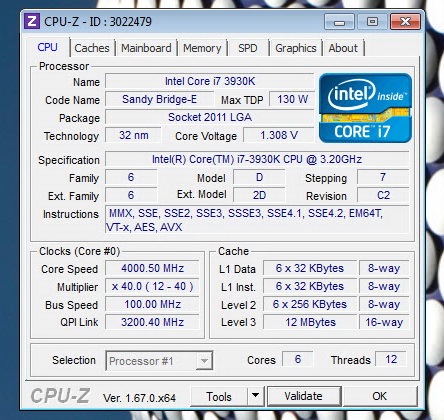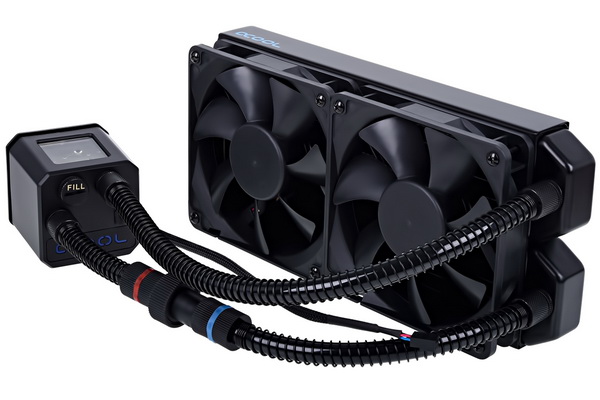INTRODUCTION
We've pointed several times in the past that CPU coolers haven't advanced much in the recent years but with AIO liquid CPU cooling solutions offering very good performance and new CPU models featuring even lower TDP (Thermal Design Power) numbers it may be a while before we actually see something new and "exciting". Still as expected that doesn't stop manufacturers from updating their AIO liquid CPU cooling lines with "upgraded" models offering improved cooling efficiencies (most of the time anyways) and new features. Of course since AIO models are basically cut-down versions of the much larger watercooling kits it only makes sense that manufacturers are always looking for ways to "bridge" the gap between both not only in terms of performance but also in features. Today with us we have one such model and more specifically the 2nd AIO liquid CPU cooling solution by Alphacool called the Eisbaer (240 model).
Alphacool are based in Germany and are one of the biggest producers of watercooling components for the PC market. Their products are sold worldwide which is testament to the quality of products they sell and are renowned for being very high performing.
The brand new Eisbaer (polar bear) AIO liquid CPU cooler by Alphacool aims to further improve both on the performance and features of its predecessor the award winning Eisberg (iceberg). To that end Alphacool has equipped the Eisbaer with a quick-lock mechanism which can be used to quickly add another radiator and even an GPU waterblock in the loop (it's also fully compatible with their GPX-Pro AIO liquid cooler which Alphacool will release later this year). In terms of specifications things are somewhat strange since Alphacool seems to have taken a step back when comparing the Eisbaer to their previous Eisberg model. So although both models feature identical radiators (278mm long and 30mm thick) and PVC tubings with anti-kink coils the brand new Eisbaer features a ceramic pump that runs at 2600RPM and can push up to 70 liters of liquid per hour up to 0.85 meters the Eisberg features a ceramic pump that runs at 3600RPM and can push up to 120 liters of water per hour up to 2.2 meters (delivery). On the other hand the brand new Eisbaer comes with two of their latest high-static pressure 120mm Eiswind sleeve-bearing fans 1700RPM speed/63.85CFM airflow/29dBA noise/1.66mm H2O air pressure) whereas the Eisberg featured two of the previous generation 120mm Coolmove 2 hydro dynamic bearing fans (1300RPM speed/58.6CFM airflow/23dBA noise/1.48mm H2O air pressure). The only question is whether or not these fans can overcome the performance difference between these two pumps although in all likelihood performance should not be impacted with just one radiator in the loop.
SPECIFICATIONS AND FEATURES

PACKAGING AND CONTENTS
Alphacool shipped all their review samples inside a black box that has a picture of the pump at the front right beneath the mainboard compatibility list (so this will probably be the retail package).
The rear part of the radiator is pictured at the rear of the box (actually this is not the radiator used since this has a fill port on it).
Packaging is standard for such products so once again everything is wrapped inside plastic bags and placed inside a formed piece of cardboard.
Aside the radiator/tubings/pump combo inside the box you will also find two 120mm Eiswind fans, 4pin Y-splitter fan cable, two pouches with the XPX Xtreme thermal paste by Gelid, backplate and all the necessary screws and mounts to install the Eisbaer onto Intel LGA 775/1150/1151/1155/1156/1366/2011/2011-3 and AMD 771/604/C32/C34/AM2/AM2+/AM3/AM3+/FM1 compatible mainboards.
THE EISBAER 240
If the Eisbaer didn't feature that quick-lock mechanism on one of its tubings it would be almost identical to the Eisberg we reviewed last year.
The radiator is a member of the NexXxoS ST30 line and measures 278mm in length, 120mm in width and 30mm in height (just like most dual 120mm radiators used in AIO models).
Fin quality is pretty much excellent as you can see from the above picture (FPI count of 16).
The PVC tubings feature anti-kink coils (just like the ones used in the Eisberg) and that's something we still haven't seen from another manufacturer (kudos to Alphacool for that).
This quick-lock mechanism allows you to connect another radiator or a graphics card waterblock in the loop with ease (or connect the upcoming GPX-Pro AIO liquid cooler).
Once again we see that Alphacool has used one of the largest pump/waterblock combos with their AIO model (unfortunately just like the Eisberg the tubings can't rotate like most other AIO models in the market).
There's a fill port ontop of the pump right next to the company logo.
This small plastic window placed on the side of the pump allows you to see the coolant level and add more if needed.
The all-copper base is polished but has quite a few stains on it (can't feel it with your fingers so it shouldn't affect performance).
Alphacool bundles two Eiswind sleeve-bearing fans with the Eisbaer and although these are "tweaked" to produce high static pressure they don't look nearly as special as the Coolmove 2 ones used in the Eisberg model (the ones bundled with the Eisbaer 280 look a lot better).
With both fans mounted on the radiator it now measures 55mm in thickness.
Once you connect the pump with your mainboard the Alphacool logo lights up and i have to admit i like it a lot more than the one found on the Eisberg (that one didn't have a LED).
TEST BED


TESTING METHODOLOGY
We always take things quite seriously when it comes to work so just like with the previous LGA1366 database we will not be testing each CPU Cooler on its own and with different ambient temperature levels and thus we can actually have yet another valid CPU Cooler database. Testing a CPU Cooler automatically means that you need to know where it stands against the immediate competition and to accomplish that we have spent both money and time through the years, something that we plan to continue to do so in order to get the most accurate results for the end consumers who read these lines. Every CPU cooler in this database is tested with the bundled 140mm/120mm/92mm/80mm fans while working at both idle speed and 100% of their speeds for all the temperature tests. CPU Coolers that do not come bundled with a fan/s are measured using a Noctua fan (size dependent on the model) to test for the temperature tests but due to the lack of a stock fan dBA level tests are obviously skipped. Single (120/140mm) watercooling solutions are tested with the radiator mounted at the rear of our test rig while dual/triple/quad (240/260/280/360/420/480/560mm) solutions with the radiator mounted at the top. For the dBA tests every cooler in the database was measured both while on idle mode or with the fan controller in the minimum setting and while on extreme load or with the fan controller all the way to the highest possible setting (PWM fans do that on their own without our intervention). Every single test takes place in a temperature controlled room of 23 degrees Celsius Ambient Temp with the help of two AC units placed diagonally inside the room. The Arctic Silver 5 thermal paste is used with every CPU Cooler in our latest LGA2011 database (although initially this was not the plan we had to change things to get the most accurate results). Finally it's very important to point out that just because a CPU Cooler is better than another when tested with our test rig that does not necessarily mean that the same performance differences will apply 100% for other CPU models and in other situations (such as different ambient temps and system configurations).
To successfully record the load temperatures we use the latest OCCT application for around 6-10 minutes to push the processor to its limits and after that is done and the temperatures are recorded we wait for about 10-20 minutes for the CPU to cool down and record the idle temperatures. This is done to allow time for the thermal conductive material to achieve the optimal performance level. Same procedure is then repeated with the Passmark BurnIn Test as a failsafe just in case the OCCT results are wrong. This procedure takes a lot more time than the usual peltier/thermometer tests but this way not only can we deliver real world results to our readers based on real CPUs but we can also triple check the results using a variety of programs. Last but not least the temperatures were recorded using both the latest versions of AIDA64 and RealTemp while the noise level tests are performed using a high precision ExTech HD600 Decibel Meter placed about 10-15cm above the CPU Cooler. Still although the same testing procedure applies to all units do take into consideration that unlike the official numbers which are measured in special noise isolated labs with just the fans here we also have both the rest of the cooler and the rest of the system (although all system fans are turned off when recording noise levels).
TEST RESULTS


CONCLUSION
While reading the specifications sheet of the Eisbaer the first thing I noticed was the less “powerful” pump used and until the moment we finished testing I didn’t know what to expect in terms of cooling efficiency. Like I said earlier however perhaps the pump used in the Eisberg was somewhat overkill for an AIO liquid CPU cooler so naturally Alphacool used a cut-down version with the Eisbaer. Now I don’t know what the results would be if we were to add a couple of radiators and a GPU waterblock on both the Eisbaer and the Eisberg but I do suspect that from a point the second would take the lead. Still I doubt there are many people out there who would connect two extra radiators and one or more GPU waterblocks to any AIO model. With that out of the way performance may not be the best we’ve ever seen from an 240mm AIO model (it does come really close to the ones at the top and it does surpass the Eisberg 240) but it’s quick-lock mechanism, excellent build quality and low noise levels are three features which will probably matter more to consumers than a couple of degrees Celsius less.
So how much does Alphacool want for their latest Eisbaer 240 AIO liquid CPU cooler? Well currently the Eisbaer 240 carries a price tag of USD120.79 plus shipping inside the USA (Aquatuning.us) and 114.99Euros plus shipping inside the EU (Aquatuning.de) so it’s exactly where we were hoping it would be. Overall we just can’t think of anything bad to say about the Eisbaer 240. Cooling efficiency is top, build quality is excellent, mainboard compatibility is better than what we could have ever hoped and noise levels are quite low (beneath those of most similar products). On top of all the above add the expandability feature thanks to the quick-lock mechanism and you have a product well worth our Platinum Award.

PROS
- Excellent Build Quality
- Top Cooling Efficiency
- Removable Tubes (Can Add Extra Radiators, GPU blocks, Pumps)
- Quick Lock Mechanism
- Low Noise Levels
- PVC Tubes With Anti-Kink Coils
- Price (For Some)
CONS
- Current Availability

 O-Sense
O-Sense

























.png)

